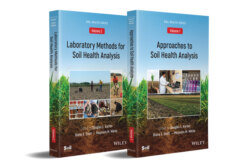Читать книгу Soil Health Analysis, Set - Группа авторов - Страница 17
Why is Soil Health Important?
ОглавлениеInvesting in regenerating, improving, or sustaining soil health will result in a broad array of benefits for producers and the public. Those benefits include: carbon sequestration and potential mitigation of and adaptation to climate change; increased soil organic carbon (SOC) stocks; increased water infiltration, storage, and availability to plants; reduced runoff, water‐induced soil erosion, and flooding; more efficient nutrient cycling and pest suppression; reduced need for agricultural inputs; protection of groundwater, surface water, and air resources, including reduced dust storm events; increased biodiversity and resilience; long‐term economic viability; and perhaps most importantly, food security, defined as sustained, reliable productivity needed to provide the food, feed, fiber, and fuel resources for an increasing world population (Glæsner et al., 2014; DeLong et al., 2015; Lal, 2015).
Aggressively pursuing continued advancement of publicly available soil health testing is critical because current chemical‐based soil‐testing approaches do not provide a complete view of the soil physical, chemical, and biological interactions and constraints that influence overall soil function. Fortunately, over the last four decades, laboratory methods have been developed and refined for studying, quantifying, and monitoring biological and physical indicators. This makes it possible to use a combination of field observations and laboratory tests to identify factors affecting a variety of soil, water, air, and plant resource concerns.
Many new biological and physical soil health assessment methods are still being refined and validated by the research community, but several indicators and laboratory methods are gradually becoming available through agricultural soil testing laboratories for assessing how well soil processes are functioning. Technical Note 450–03 (USDA‐NRCS, 2019b) was published by NRCS to provide recommendations reflecting current best available methods compiled through meetings and working groups involving more than 100 scientists who collaborated in multiorganizational workshops co‐organized by USDA‐NRCS Soil Health Division and members of the Soil Renaissance effort. The Technical Note laboratory methods are used as part of the Conservation Innovation Grants Soil Health Demonstration Trials minimum dataset and in a newly available Soil Testing Conservation Activity (CA 216) standard (USDA‐NRCS, 2020c). Standardization of methods enables nationwide baseline measurements to be obtained that can be used for monitoring, and to guide soil and crop management when combined with a soil health assessment framework that provides soil and climate adapted interpretations of raw laboratory values. These book volumes are intended to summarize current best available methods and to identify gaps in our current understanding of soil health measurement and assessment. They are also intended to facilitate and increase in public awareness of soil health assessment and to provide insight and science‐based methods for those evaluations. Furthermore, by encouraging soil health assessments, we hope these volumes will ultimately result in compilation of a national dataset that can be used to support multiple public and private soil health goals and document the value of public and private investments in such assessments.
While qualitative or semi‐quantitative field observations can be used for preliminary identification of soil health constraints or to improve soil and crop management practices, identifying specific underlying causes and/or the management practices needed to address them, often requires quantitative laboratory analysis. We anticipate information in these volumes will be used by a wide group of stakeholders including producers, consultants, technical service providers, conservation planners, and other private and public agricultural service providers, conservation groups, researchers, industry, policymakers, and the general public. Uses will include: (1) identifying soil health problems and planning and implementing soil health management systems; (2) innovating, monitoring, and continually improving soil health management systems and their outcomes; and (3) leveraging diverse partnerships and efforts across multiple organizations and geographical scales for further research and innovation in soil health assessment and management at local, regional, national, and global scales through standardized datasets and sharing information for agricultural lands. Having meaningful, science‐based soil health assessments is also important for planning, implementing, and managing conservation projects, establishing baselines, and documenting soil property and process changes over time to quantify outcomes of such projects.
